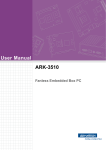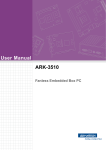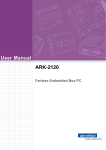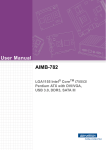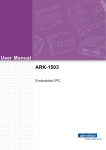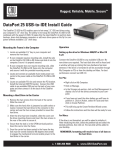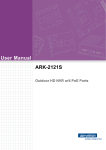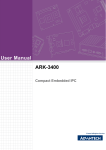Download User Manual ARK-1550
Transcript
User Manual ARK-1550 Embedded IPC Attention! This package contains a hard-copy user manual in Chinese for China CCC certification purposes, and there is an English user manual included as a PDF file on the CD. Please disregard the Chinese hard copy user manual if the product is not to be sold and/or installed in China. ARK-1550 User Manual ii Copyright The documentation and the software included with this product are copyrighted 2014 by Advantech Co., Ltd. All rights are reserved. Advantech Co., Ltd. reserves the right to make improvements in the products described in this manual at any time without notice. No part of this manual may be reproduced, copied, translated or transmitted in any form or by any means without the prior written permission of Advantech Co., Ltd. Information provided in this manual is intended to be accurate and reliable. However, Advantech Co., Ltd. assumes no responsibility for its use, nor for any infringements of the rights of third parties, which may result from its use. Acknowledgements Award is a trademark of Award Software International, Inc. VIA is a trademark of VIA Technologies, Inc. IBM, PC/AT, PS/2 and VGA are trademarks of International Business Machines Corporation. Intel® and Pentium® are trademarks of Intel Corporation. Microsoft Windows® is a registered trademark of Microsoft Corp. RTL is a trademark of Realtek Semi-Conductor Co., Ltd. ESS is a trademark of ESS Technology, Inc. UMC is a trademark of United Microelectronics Corporation. SMI is a trademark of Silicon Motion, Inc. Creative is a trademark of Creative Technology LTD. CHRONTEL is a trademark of Chrontel Inc. All other product names or trademarks are properties of their respective owners. For more information about this and other Advantech products, please visit our website at: http://www.advantech.com/ http://www.advantech.com/ePlatform/ For technical support and service, please visit our support website at: http://support.advantech.com.tw/support/ Part No. 2006K15500 Edition 1 Printed in China May 2014 iii ARK-1550 User Manual Product Warranty (2 years) Advantech warrants to you, the original purchaser, that each of its products will be free from defects in materials and workmanship for two years from the date of purchase. This warranty does not apply to any products which have been repaired or altered by persons other than repair personnel authorized by Advantech, or which have been subject to misuse, abuse, accident or improper installation. Advantech assumes no liability under the terms of this warranty as a consequence of such events. Because of Advantech’s high quality-control standards and rigorous testing, most of our customers never need to use our repair service. If an Advantech product is defective, it will be repaired or replaced at no charge during the warranty period. For outof-warranty repairs, you will be billed according to the cost of replacement materials, service time and freight. Please consult your dealer for more details. If you think you have a defective product, follow these steps: 1. Collect all the information about the problem encountered. (For example, CPU speed, Advantech products used, other hardware and software used, etc.) Note anything abnormal and list any onscreen messages you get when the problem occurs. 2. Call your dealer and describe the problem. Please have your manual, product, and any helpful information readily available. 3. If your product is diagnosed as defective, obtain an RMA (return merchandise authorization) number from your dealer. This allows us to process your return more quickly. 4. Carefully pack the defective product, a fully-completed Repair and Replacement Order Card and a photocopy proof of purchase date (such as your sales receipt) in a shippable container. A product returned without proof of the purchase date is not eligible for warranty service. 5. Write the RMA number visibly on the outside of the package and ship it prepaid to your dealer. Declaration of Conformity FCC Class A Note: This equipment has been tested and found to comply with the limits for a Class A digital device, pursuant to part 15 of the FCC Rules. These limits are designed to provide reasonable protection against harmful interference when the equipment is operated in a commercial environment. This equipment generates, uses, and can radiate radio frequency energy and, if not installed and used in accordance with the instruction manual, may cause harmful interference to radio communications. Operation of this equipment in a residential area is likely to cause harmful interference in which case the user will be required to correct the interference at his own expense. ARK-1550 User Manual iv Technical Support and Assistance 1. 2. Visit the Advantech web site at www.advantech.com/support where you can find the latest information about the product. Contact your distributor, sales representative, or Advantech's customer service center for technical support if you need additional assistance. Please have the following information ready before you call: – Product name and serial number – Description of your peripheral attachments – Description of your software (operating system, version, application software, etc.) – A complete description of the problem – The exact wording of any error messages Warnings, Cautions and Notes Warning! Warnings indicate conditions, which if not observed, can cause personal injury! Caution! Cautions are included to help you avoid damaging hardware or losing data. Note! Notes provide optional additional information. v ARK-1550 User Manual Safety Instructions 1. 2. 3. 4. 5. 6. 7. 8. 9. 10. 11. 12. 13. 14. 15. 16. Read these safety instructions carefully. Keep this User Manual for later reference. Disconnect this equipment from any AC outlet before cleaning. Use a damp cloth. Do not use liquid or spray detergents for cleaning. For plug-in equipment, the power outlet socket must be located near the equipment and must be easily accessible. Keep this equipment away from humidity. Put this equipment on a reliable surface during installation. Dropping it or letting it fall may cause damage. The openings on the enclosure are for air convection. Protect the equipment from overheating. DO NOT COVER THE OPENINGS. Make sure the voltage of the power source is correct before connecting the equipment to the power outlet. Position the power cord so that people cannot step on it. Do not place anything over the power cord. All cautions and warnings on the equipment should be noted. If the equipment is not used for a long time, disconnect it from the power source to avoid damage by transient overvoltage. Never pour any liquid into an opening. This may cause fire or electrical shock. Never open the equipment. For safety reasons, the equipment should be opened only by qualified service personnel. If one of the following situations arises, get the equipment checked by service personnel: The power cord or plug is damaged. Liquid has penetrated into the equipment. The equipment has been exposed to moisture. The equipment does not work well, or you cannot get it to work according to the user's manual. The equipment has been dropped and damaged. The equipment has obvious signs of breakage. DO NOT LEAVE THIS EQUIPMENT IN AN ENVIRONMENT WHERE THE STORAGE TEMPERATURE MAY GO BELOW -20° C (-4° F) OR ABOVE 60° C (140° F). THIS COULD DAMAGE THE EQUIPMENT. THE EQUIPMENT SHOULD BE IN A CONTROLLED ENVIRONMENT. CAUTION: Any unverified component could cause unexpected damage. To ensure the correct installation, please always use the components (ex. screws) provided with the accessory box. ATTENTION: Tout composant non vérifiée pourrait causer des dommages inattendu. Pour garantir une installation correcte, s'il vous plaît utilisez toujours les composants (vis ex.) fournies avec la boîte d'accessoires. 17. CAUTION: The computer is provided with a battery-powered real-time clock circuit. There is a danger of explosion if battery is incorrectly replaced. Replace only with same or equivalent type recommended by the manufacture. Discard used batteries according to the manufacturers instructions. ATTENTION: L'ordinateur est muni d'un circuit en temps réel de l'horloge alimentée par batterie. Il ya un danger d'explosion si la pile est remplacée de façon incorrecte. Remplacez uniquement par un type identique ou équivalent ARK-1550 User Manual vi recommandé par le fabricant. Jetez les piles usagées selon les instructions du fabricant. 18. CAUTION: Always completely disconnect the power cord from your chassis whenever you work with the hardware. Do not make connections while the power is on. Sensitive electronic components can be damaged by sudden power surges. ATTENTION: Toujours débrancher complètement le cordon d'alimentation de votre châssis lorsque vous travaillez avec le matériel. Ne pas effectuer les raccordements lorsque l'appareil est sur. Composants électroniques sensibles peuvent être endommagés par les surtensions soudaines. The sound pressure level at the operator's position according to IEC 704-1:1982 is no more than 70 dB (A). DISCLAIMER: This set of instructions is given according to IEC 704-1. Advantech disclaims all responsibility for the accuracy of any statements contained herein. Packing List Before installation, please ensure the following items have been shipped: 1 x ARK-1550 Unit 1 x China RoHS 1 x Chinese User Manual for CCC 1 x Warranty Card 1 x Power Bracket 1 x CPU Thermal Pad Ordering Information Model Number Description ARK-1550-S6A1E Intel Celeron DC 2980U 1.6 GHz w/HDMI+LAN+GPIO ARK-1550-S9A1E Intel Core i5 DC 4300U 1.9 GHz w/HDMI+LAN+GPIO vii ARK-1550 User Manual Optional Accessories 1757003934 AC-to-DC Adapter, DC 12V/5A 60W, with DC Jack Plug, 0 ~ 40° C for Home and Office Use 1757004522-01 AC-to-DC Wide Temperature Adapter, DC 12V/3.33A 40W, -20° C ~ 70° C 1702002600-01 Power cable 3-pin 183 cm, USA type (For power adapter 1757003934 & 1757004522-01) 1700018705 Power cable 3-pin 183 cm, Europe type (For power adapter 1757003934 & 1757004522-01) 1700018704 Power cable 3-pin 183 cm, UK type (For power adapter 1757003934 & 1757004522-01) 1700000237-01 Power cable 3-pin 183 cm, PSE type (For power adapter 1757003934 & 1757004522-01) 1960064584N000 Power bracket for 1757004522-01 AMK-V004E VESA mounting kit AMK-R002E DIN-rail mounting kit AMK-V006E Panel mounting kit ARK-1550 User Manual viii Contents Chapter 1 General Introduction ...........................1 1.1 1.2 Introduction ............................................................................................... 2 Product Features....................................................................................... 2 1.2.1 Key Features................................................................................. 2 1.2.2 Graphics........................................................................................ 2 1.2.3 Power Consumption...................................................................... 2 Hardware Specification ............................................................................. 3 Mechanical Specification........................................................................... 4 1.4.1 Dimensions ................................................................................... 4 Figure 1.1 ARK-1550 Mechanical dimension drawing................. 4 1.4.2 Weight........................................................................................... 4 Power Requirement .................................................................................. 4 1.5.1 System Power............................................................................... 4 1.5.2 RTC Battery .................................................................................. 4 Environmental Specification...................................................................... 5 1.6.1 Operating Temperature................................................................. 5 1.6.2 Relative Humidity .......................................................................... 5 1.6.3 Storage Temperature.................................................................... 5 1.6.4 Vibration during Operation ............................................................ 5 1.6.5 Shock during Operation ................................................................ 5 1.6.6 Safety............................................................................................ 5 1.6.7 EMC .............................................................................................. 5 1.3 1.4 1.5 1.6 Chapter 2 Hardware installation ..........................7 2.1 2.2 Introduction ............................................................................................... 8 Jumpers .................................................................................................... 8 2.2.1 Jumper List ................................................................................... 8 2.2.2 Jumper Settings ............................................................................ 8 2.2.3 Auto Power On Setting (J2) .......................................................... 9 Table 2.1: Auto Power On Setting (J2)........................................ 9 2.2.4 LCD Power (J3) ............................................................................ 9 Table 2.2: LCD Power (J3) .......................................................... 9 2.2.5 PCIe & mSATA Selection (SW2) .................................................. 9 Table 2.3: mPCIe & mSATA Selection (SW2)............................. 9 2.2.6 Clear CMOS (SW3) .................................................................... 10 Table 2.4: Clear CMOS (SW3) .................................................. 10 ARK-1550 I/O Indication ......................................................................... 10 Figure 2.1 ARK-1550 Front View............................................... 10 Figure 2.2 ARK-1550 Rear View ............................................... 10 ARK-1550 External I/O Connectors ........................................................ 11 2.4.1 Power ON/OFF Button................................................................ 11 Figure 2.3 Power ON/OFF Button ............................................. 11 2.4.2 Power Input Connector ............................................................... 11 Figure 2.4 Power Input Connector............................................. 11 2.4.3 Ethernet Connector (LAN) .......................................................... 11 Figure 2.5 Ethernet Connector .................................................. 11 Table 2.5: Ethernet Connector Pin Assignments....................... 11 2.4.4 VGA Connector........................................................................... 12 Figure 2.6 VGA Connector ........................................................ 12 Table 2.6: VGA Connector Pin Assignments............................. 12 2.4.5 USB Connectors ......................................................................... 12 Figure 2.7 USB Connector [Upper (black): USB2.0 / Down (blue): USB 3.0] ................................................................... 12 2.3 2.4 ix ARK-1550 User Manual Table 2.7: USB Connector Pin Assignments............................. 12 Audio Connector (ARK-1550F only) ........................................... 13 Figure 2.8 Line-out Connector................................................... 13 Table 2.8: Audio Connector Pin Assignments........................... 13 2.4.7 COM Connector.......................................................................... 13 Figure 2.9 COM Port Connector................................................ 13 Table 2.9: COM Connector Pin Assignments............................ 13 2.4.8 DIO Connector............................................................................ 14 Figure 2.10DIO Connector ......................................................... 14 Table 2.10: DIO Connector Pin Assignments.............................. 14 2.4.9 HDMI Connector ......................................................................... 14 Figure 2.11HDMI Connector....................................................... 14 Table 2.11: HDMI / Display Port Connector Pin Assignments .... 14 2.4.10 LED Indicator .............................................................................. 15 Figure 2.12LED Indicator............................................................ 15 2.4.11 LVDS Connector (Optional) ........................................................ 15 Figure 2.13LVDS Connector ...................................................... 15 Table 2.12: LVDS Connector Pin Assignment ............................ 15 2.4.12 LCD Backlight On/Off Control Connector (Optional) .................. 16 Figure 2.14LCD Backlight connector.......................................... 16 Table 2.13: LCD Backlight Connector Pin Assignment ............... 16 Optional Peripheral Installation ............................................................... 17 2.5.1 RAM Installation.......................................................................... 17 2.5.2 HDD Installation.......................................................................... 18 2.5.3 mSATA Installation ..................................................................... 19 2.5.4 WIFI / 3G Module Installation ..................................................... 19 2.4.6 2.5 Chapter 3 BIOS settings .................................... 21 3.1 Introduction ............................................................................................. 22 Figure 3.1 Setup program initial screen..................................... 22 Entering Setup ........................................................................................ 23 3.2.1 Main Setup.................................................................................. 23 Figure 3.2 Main setup screen .................................................... 23 3.2.2 Advanced BIOS Features Setup................................................. 24 Figure 3.3 Advanced BIOS features setup screen .................... 24 Figure 3.4 PCI Subsystem Settings........................................... 25 Figure 3.5 PCI Express Device Register Settings ..................... 26 Figure 3.6 ACPI Setting............................................................. 27 Figure 3.7 Trusted Computing Configuration ............................ 28 Figure 3.8 S5 RTC Wake Settings ............................................ 29 Figure 3.9 CPU Configuration Setting ....................................... 30 Figure 3.10SATA Configuration.................................................. 31 Figure 3.11Intel® Rapid Technology .......................................... 32 Figure 3.12AMT Configuration ................................................... 33 Figure 3.13PCH-FW Configuration............................................. 34 Figure 3.14USB Configuration.................................................... 35 Figure 3.15Embedded Controller Configuration ......................... 36 Figure 3.16Super IO Configuration............................................. 37 Figure 3.17Serial Port Console Redirection ............................... 38 3.2.3 Chipset........................................................................................ 39 Figure 3.18Chipset Setup........................................................... 39 Figure 3.19System Agent (SA) Configuration ............................ 40 Figure 3.20Intel IGFX Configuration........................................... 41 Figure 3.21LCD Control.............................................................. 42 Figure 3.22Memory Configuration .............................................. 43 Figure 3.23PCH-IO Configuration .............................................. 44 Figure 3.24PCI Express Configuration ....................................... 45 Figure 3.25USB Configuration.................................................... 46 3.2 ARK-1550 User Manual x 3.2.4 3.2.5 3.2.6 Figure 3.26PCH Azalia Configuration......................................... 47 Boot Settings............................................................................... 48 Figure 3.27Boot Setup Utility ...................................................... 48 Security Setup............................................................................. 49 Figure 3.28Password Configuration ........................................... 49 Save & Exit ................................................................................. 50 Figure 3.29Save & Exit ............................................................... 50 Appendix A WDT Sample Code.............................53 A.1 Watchdog Timer Sample Code ............................................................... 54 xi ARK-1550 User Manual ARK-1550 User Manual xii Chapter 1 1 General Introduction This chapter gives background information on ARK-1550 series. 1.1 Introduction ARK-1550 Fanless Embedded Box PC is an application ready system platform solution. All electronics are protected in a compact sealed aluminum case for easy integration in the customer's own housing, or as a stand-alone application, where space is limited and the environment harsh. ARK-1550 is a new single board design made very slim. The dimensions are only 223 x 46.6 x 133.0 mm. ARK-1550 can be easily integrated with panel/displays within limited spaces and can be installed anywhere due to its slim dimensions with optional DIN rail and VESA mounting solutions. ARK-1550 optimizes space and offers 2*USB 2.0, 2*USB 3.0, 1*VGA, 1*HDMI, 1*LVDS(optional), 3*COM, 1*DIO, 2*GbE LANs and 1*hot swappable 2.5" drive bay. Also, ARK-1550 can provide 2*MiniPCIe slot for future extensions. The ARK-1550 compact design can provide up to 5 Grms vibration and 50G shock protections and wide temperature support from -20-55 °C under harsh environment. ARK-1550 is powered by 12V DC input and adopts the latest Intel 4th generation core i5 4300U DC 1.9 GHz and Celeron 2980U DC 1.6 GHz CPUs which meet most requirements. ARK-1550 is the ideal choice for cost/performance value for customers. 1.2 Product Features 1.2.1 Key Features Intel Celeron 2980U DC 1.6 GHz / Core i5 4300U DC 1.9 GHz SoC Optimized spaces by slim dimension : 223 x 46.6 x 133.0 mm One Hot Swappable 2.5" SATA HDD Bay and one mSATA slot Triple Independent Displays by VGA + HDMI + LVDS (optional) Optional VESA / DIN Rail Mounting kits with lockable DC jack design Built-in 1 x full size MiniPCIe (i.e.: 3G module) and 1 x half size MiniPCIe slot (i.e.: WIFI module) 1.2.2 Graphics Chipset: Intel HD Graphics (Celeron) / Intel HD Graphics 4400 (Core i5) Graphic Engine: DirectX* 11.1, OpenGL* 4.0 support. Full AVC/VC1/MPEG2 HW Decode VGA: DB15, resolution up to 1920 x 1200. HDMI: Lockable HDMI connector, resolution up to 4096 x 2304 LVDS (Option): Resolution up to 1920 x 1200 1.2.3 Power Consumption Burn-in test (Full Loading): 16.8 W (Core i5) OS Idle mode (Typical): 2.64 W (Core i5) ARK-1550 User Manual 2 3 ARK-1550 User Manual General Introduction CPU: Intel® 4th generation DC Core i5 4300U 1.91GHz / DC Celeron 2980U 1.66 GHz System Chipset: Intel® HD Graphics 4400 BIOS: AMI EFI 128 Mbit System Memory: 1 x 204-pin SO-DIMM DDR3L 1333/1600 MHz, support up to 8GB Display: – VGA: Up to 1920 x 1200 at 60 Hz – HDMI: Up to 4096 x 2304 at 24 Hz – LVDS (optional by T-PN): Up to 1920 x 1200 at 60 Hz Storage: – 1 x hot swappable 2.5" SATA HDD (maximum height: 9.5 mm) – 1 x Full size mSATA Watchdog Timer: 255-level timer interval, setup by software I/O Interface: – COM: 1 x RS-232, 2 x RS-232/422/485 (BIOS selectable) – USB: 2 x USB 2.0, 2 x USB 3.0 – LAN1: Intel I218 GbE, support wake on LAN – LAN2: Intel I210 GbE, support wake on LAN – DIO: 8-bit DIO – Audio: Realtek ALC888S, High Definition Audio. Line-out, Mic-in, Line-in Expansion: – 1 x Full-size Mini PCIe slot w/ SIM holder, support mSATA storage or WWAN module – 1 x Half-size Mini PCIe slot, support WLAN module Chapter 1 1.3 Hardware Specification 1.4 Mechanical Specification 1.4.1 Dimensions 223 x 46.6 x 133.0 mm (8.69" x 1.81" x 5.18") Figure 1.1 ARK-1550 Mechanical dimension drawing 1.4.2 Weight 1.9 kg (4.18 lbs) 1.5 Power Requirement 1.5.1 System Power Minimum power input: DC 12 V/5 A 60 W 1.5.2 RTC Battery Typical Voltage: 3.0 V Normal discharge capacity: 210 mAh ARK-1550 User Manual 4 1.6.1 Operating Temperature With extended temperature SSD/ mSATA /RAM :-20 ~ 55 °C with 0.7m/s air flow With standard temperature HDD/ SSD/ mSATA/ RAM : 0 ~ 40 °C with 0.7m/s air flow Chapter 1 1.6 Environmental Specification 1.6.2 Relative Humidity 95% @ 40 °C (non-condensing) 1.6.3 Storage Temperature -40 ~ 85 °C (-40 ~ 185 °F) 1.6.4 Vibration during Operation With mSATA/ SSD: 5 Grms, IEC 60068-2-64, random, 5 ~ 500 Hz, 1 hr/axis 1.6.5 Shock during Operation With mSATA/SSD: 50 G, IEC 60068-2-27, half sine, 11 ms duration 1.6.6 Safety UL, CCC, BSMI, CB 1.6.7 EMC CE/FCC Class A, CCC, BSMI 5 ARK-1550 User Manual General Introduction ARK-1550 User Manual 6 Chapter 2 2 Hardware installation This chapter introduces external IO and the installation of ARK-1550 Hardware. 2.1 Introduction The following sections show the internal jumper settings and the external connectors and pins assignment for applications. 2.2 Jumpers 2.2.1 Jumper List The ARK-1550 has a number of jumpers that allow you to configure your system to suit your application. The table below lists the functions of the various jumpers. Jumpers & Switches J2 Auto Power On Setting J3 LCD Power SW2 mPCIe & mSATA selection SW3 Clear CMOS 2.2.2 Jumper Settings Cards can be configured by setting jumpers. A jumper is a metal bridge used to close an electric circuit. It consists of two metal pins and a small metal clip (often protected by a plastic cover) that slides over the pins to connect them. To close a jumper, you connect the pins with the clip. To open a jumper, you remove the clip. Sometimes a jumper will have three pins, labeled 1, 2 and 3. In this case you would connect either pins 1 and 2, or 2 and 3. The jumper settings are schematically depicted in this manual as follows. A pair of needle-nose pliers may be helpful when working with jumpers. If you have any doubts about the best hardware configuration for your application, contact your local distributor or sales representative before you make any changes. Generally, you simply need a standard cable to make most connections. ARK-1550 User Manual 8 Chapter 2 2.2.3 Auto Power On Setting (J2) Table 2.1: Auto Power On Setting (J2) Function NC Power Button for Power On (1-2)* Auto Power On (default) 2.2.4 LCD Power (J3) (1-3)* (3-5) (3-4) Table 2.2: LCD Power (J3) Setting Function (1-3)* +3.3V (default) (3-5) +5V (3-4) +12V 2.2.5 PCIe & mSATA Selection (SW2) (1 & 2)* (3 & 4) (2 & 4) Table 2.3: mPCIe & mSATA Selection (SW2) Setting Function (1 & 2)* mSATA (default) (3 & 4) mPCIe (2 & 4) Auto Detect1 1 Some of mSATA or mPCIe modules can't be recognized correctly through the Auto Detect setting. Suggest to use mSATA or mPCIe setting directly if meet any compatibility problem. 9 ARK-1550 User Manual Hardware installation Setting 2.2.6 Clear CMOS (SW3) (1-2)* (2-3) Table 2.4: Clear CMOS (SW3) Setting Function (1-2)* Normal (2-3) Clear CMOS 2.3 ARK-1550 I/O Indication Figure 2.1 ARK-1550 Front View Figure 2.2 ARK-1550 Rear View ARK-1550 User Manual 10 2.4.1 Power ON/OFF Button ARK-1550 comes with a Power On/Off button, that support dual function of Soft Power -On/Off (Instant off or Delay 4 Second), and Suspend. 2.4.2 Power Input Connector ARK-1550 comes with a DC-Jack header that carries 12 VDC external power input. The power connector can be fixed by a bracket which is in the accessory box. The bracket can avoid power connector to fall off. Figure 2.4 Power Input Connector 2.4.3 Ethernet Connector (LAN) ARK-1550 provides two RJ45 LAN interface connectors, which are fully compliant with IEEE 802.3u 10/100/1000 Base-T CSMA/CD standards. LAN1 is equipped with Intel I218 GbE and LAN2 is equipped with Intel I210 GbE. The Ethernet ports use standard RJ-45 jack connectors with LED indicators on the front side to show Active/ Link status and Speed status. 8 1 Figure 2.5 Ethernet Connector Table 2.5: Ethernet Connector Pin Assignments Pin Signal Name Pin Signal Name 1 TX+(10/100),BI_DA+(GHz) 5 BI_DC-(GHz) 2 TX-(10/100),BI_DA-(GHz) 6 RX-(10/100),BI_DB-(GHz) 3 RX+(10/100),BI_DB+(GHz) 7 BI_DD+(GHz) 4 BI_DC+(GHz) 8 BI_DD-(GHz) 11 ARK-1550 User Manual Hardware installation Figure 2.3 Power ON/OFF Button Chapter 2 2.4 ARK-1550 External I/O Connectors 2.4.4 VGA Connector The ARK-1550 provides a high resolution VGA interface connected by a D-sub 15pin connector to support a VGA CRT monitor. It supports display resolution of up to 1920 x 1200 with 60 Hz. 5 10 15 1 6 11 Figure 2.6 VGA Connector Table 2.6: VGA Connector Pin Assignments Pin Signal Name Pin Signal Name 1 Red 2 Green 3 Blue 4 NC 5 GND 6 GND 7 GND 8 GND 9 NC 10 GND 11 NC 12 DDC Date 13 H-SYNC 14 V-SYNC 15 DDC Clock 2.4.5 USB Connectors The ARK-1550 provides up to four USB interface connectors – 2 x USB 2.0 & 2 x USB 3.0, which give complete Plug & Play. The USB interface is compliant with USB UHCI, Rev. 2.0 & 3.0. The USB interface supports Plug and Play, which enables you to connect or disconnect a device whenever you want, without turning off the computer. Figure 2.7 USB Connector [Upper (black): USB2.0 / Down (blue): USB 3.0] Table 2.7: USB Connector Pin Assignments Pin Signal Name Pin Signal Name 1 +5V 2 D- 3 D+ 4 GND 5 SSRX- 6 SSRX+ 7 GND 8 SSTX- 9 SSTX+ 10 +5V ARK-1550 User Manual 12 D- 13 GND 12 D+ 2.4.6 Audio Connector (ARK-1550F only) ARK-1550 offers stereo audio ports by a phone jack connector of Line-out, Mic-in & Line-in. The audio chip controller is by Realtek ALC888, High Definition Audio. Table 2.8: Audio Connector Pin Assignments Pin Audio Signal Name 1 MIC 2 Line-In 3 Line-Out 2.4.7 COM Connector ARK-1550 provides three D-sub 9-pin connectors, which offers 1 x RS-232 & 2 x RS232/422/485 serial communication ports (BIOS selectable). COM 1: RS-232 COM 2: RS-232/422/485 COM3: RS-232/422/485 Figure 2.9 COM Port Connector Table 2.9: COM Connector Pin Assignments RS-232 RS-422 RS-485 Pin Signal Name Signal Name Signal Name 1 DCD Tx- DATA- 2 RxD Tx+ DATA+ 3 TxD Rx+ NC 4 DTR Rx- NC 5 GND GND GND 6 DSR NC NC 7 RTS NC NC 8 CTS NC NC 9 RI NC NC 13 ARK-1550 User Manual Hardware installation Figure 2.8 Line-out Connector Chapter 2 11 2.4.8 DIO Connector ARK-1550 offers an 8-bit DIO connector and one ground pin. Each bit of DIO can be set as digital input or output independently. The direction of each bit can be set via Advantech SUSI utility. Figure 2.10 DIO Connector Table 2.10: DIO Connector Pin Assignments Pin Signal Name 1 DIO bit0 2 DIO bit1 3 DIO bit2 4 DIO bit3 5 DIO bit4 6 DIO bit5 7 DIO bit6 8 DIO bit7 9 GND 2.4.9 HDMI Connector ARK-1550 provides 1 x lockable HDMI port which resolution can support up to 4096 x 2304 at 24 Hz. Figure 2.11 HDMI Connector Table 2.11: HDMI / Display Port Connector Pin Assignments Pin Signal Name Pin Signal Name 1 TMDS_Data2+/ DP_Data0+ 2 GND 3 TMDS_Data2−/ DP_Data0- 4 TMDS_Data1+/ DP_Data1+ 5 GND 6 TMDS_Data1−/ DP_Data1- 7 TMDS_Data0+/ DP_Data2+ 8 GND 9 TMDS_Data0-/ DP_Data2- 10 TMDS_Clock+/ DP_Data3+ 11 GND 12 TMDS_Clock−/ DP_Data3- 13 NC 14 NC 15 SCL/ AUX_CH+ 16 SDA/ GND 17 DDC GND/ AUX_CH- 18 +5V/ Hot plug detect 19 Hot plug detect/ Return 20 DP_PWR ARK-1550 User Manual 14 There are two LEDs on ARK-1550 front metal face plate for indicating system status: PWR LED is for power status; and HDD LED is for HDD flash disk status. Chapter 2 2.4.10 LED Indicator Figure 2.12 LED Indicator The ARK-1550 comes with a D-Sub 26-pin connector that carries LVDS signal output, and can direct connect to LVDS LCD Display via external cable. The system also provides a jumper J3 on the internal motherboard for selecting the LCD signal power of 3.3V, 5V or 12V, please refer to the jumper table of J3 to adjust it. The default setting of J3 is 3.3V. Figure 2.13 LVDS Connector Table 2.12: LVDS Connector Pin Assignment Pin Signal Name Pin Signal name 1 LVDS_CLKBP 14 LVDS_CLKBM 2 GND 15 LVDS_YAM0 3 LVDS_YAP0 16 LVDS_YAM1 4 LVDS_YAP1 17 LVDS_YAM2 5 LVDS_YAP2 18 LVDS_CLKAM 6 LVDS_CLKAP 19 GND 7 3.3V, 5V or 12V 20 3.3V, 5V or 12V 8 GND 21 LVDS_YAM3 9 LVDS_YAP3 22 LVDS_YBM0 10 LVDS_YBP0 23 LVDS_YBM1 11 LVDS_YBP1 24 LVDS_YBM2 12 LVDS_YBP2 25 LVDS_YBM3 13 LVDS_YBP3 26 GND 15 ARK-1550 User Manual Hardware installation 2.4.11 LVDS Connector (Optional) 2.4.12 LCD Backlight On/Off Control Connector (Optional) ARK-1550 comes with a D-Sub 9-pin connector which provides BKLTEN signal as well as +12 V, +5 V and Ground Pin signals that allow the user to connect these signals to LCD Inverter to implement the LCD On/Off control. Provides BKLTEN signal that inverter Module requires for inverter on/off control Provides 12 V, 5 V as the Inverter Power Source. The additional VBR signal pin could be connected to LCD’s Inverter that allows the user to achieve brightness adjustment through customer’s software utility. Figure 2.14 LCD Backlight connector Table 2.13: LCD Backlight Connector Pin Assignment Pin Signal name 1 +12 V 2 GND 3 BKLTEN 4 VBR 5 +5 V 6 LVDS_DCLK 7 LVDS_DDAT 8 GND 9 Reserved ARK-1550 User Manual 16 2.5.1 RAM Installation Remove top cover screw * 4pcs and right/left side screws * 4pcs. Remove top cover and then see memory socket. 3. Install memory. (memory is for optional, not in standard shipment) Hardware installation 1. 2. Chapter 2 2.5 Optional Peripheral Installation 17 ARK-1550 User Manual 2.5.2 HDD Installation 1. Loosen the screws marked in red and take out the hard drive tray. 2. Install the hard drive on the tray (screws are included in accessory box). 3. Secure the screws on the hard drive tray and push the tray back into the unit. ARK-1550 User Manual 18 1. 2. Remove the bottom cover screws and then remove the bottom cover. mSATA storage can be installed in the full-size mini PCIe slot marked in red. (screws are included in accessory box) 3. Replace bottom cover and secure the bottom cover screws. ** mSATA storage and 3G module cannot be installed at the same time. Chapter 2 2.5.3 mSATA Installation Hardware installation 2.5.4 WIFI / 3G Module Installation 1. 2. 3. 4. Remove the bottom cover screws and then remove the bottom cover. The 3G module can be installed in the full-size mini PCIe slot marked in red. (screws are included in accessory box) The WIFI module can be installed in the half-size mini PCIe slot marked in yellow. (screws are included in accessory box) Replace the bottom cover and secure the bottom cover screws. 19 ARK-1550 User Manual ARK-1550 User Manual 20 Chapter 3 3 BIOS settings This chapter introduces how to set BIOS configuration data. 3.1 Introduction AMIBIOS has been integrated into many motherboards for over a decade. With the AMIBIOS Setup program, you can modify BIOS settings and control the various system features. This chapter describes the basic navigation of the ARK-1550 BIOS setup screens. Figure 3.1 Setup program initial screen AMI's BIOS ROM has a built-in setup program that allows users to modify the basic system configuration. This information is stored in battery-backed CMOS so it retains the setup information when the power is turned off. ARK-1550 User Manual 22 Turn on the computer and then press <F2> or <DEL> to enter the Setup menu. 3.2.1 Main Setup When you first enter the BIOS Setup Utility, you will enter the Main setup screen. You can always return to the Main setup screen by selecting the Main tab. There are two Main Setup options. They are described in this section. The Main BIOS Setup screen is shown below. Chapter 3 3.2 Entering Setup BIOS settings Figure 3.2 Main setup screen The Main BIOS setup screen has two main frames. The left frame displays all the options that can be configured. Grayed-out options cannot be configured; options in blue can. The right frame displays the key legend. Above the key legend is an area reserved for a text message. When an option is selected in the left frame, it is highlighted in white. Often a text message will accompany it. System Time / System Date Use this option to change the system time and date. Highlight System Time or System Date using the <Arrow> keys. Enter new values through the keyboard. Press the <Tab> key or the <Arrow> keys to move between fields. The date must be entered in MM/DD/YY format. The time must be entered in HH:MM:SS format. 23 ARK-1550 User Manual 3.2.2 Advanced BIOS Features Setup Select the Advanced tab from the ARK-1550 setup screen to enter the Advanced BIOS Setup screen. You can select any of the items in the left frame of the screen, such as CPU Configuration, to go to the sub menu for that item. You can display an Advanced BIOS Setup option by highlighting it using the <Arrow> keys. All Advanced BIOS Setup options are described in this section. The Advanced BIOS Setup screens are shown below. The sub menus are described on the following pages. Figure 3.3 Advanced BIOS features setup screen ARK-1550 User Manual 24 Chapter 3 3.2.2.1 PCI Subsystem Settings BIOS settings Figure 3.4 PCI Subsystem Settings PCI Latency Timer This item allows users to program the PCI Latency timer. VGA Palette Snoop This item allows users to enable or disable VGA Palette Snoop. PERR# Generation This item allows users to enable or disable PERR# Generation. SERR# Generation This item allows users to enable or disable SERR# Generation 25 ARK-1550 User Manual 3.2.2.2 PCI Express Device Register Settings Figure 3.5 PCI Express Device Register Settings Relaxed Ordering Enable or disable Relaxed Ordering Extended Tag Enable or disable Extended Tag No Snoop Enable or disable No Snoop Maximum Payload This item allows users to set the Maximum Payload Maximum Read Request This item allows users to set the Maximum Read Request ASPM Support Enable or disable ASPM Support Extended Synch Enable or disable Extended Synch Link Training Retry This item allows users to set the Link Training Retry Link Training Timeout (uS) This item allows users to set the Link Training Timeout (uS) Unpopulated Links This item allows users to set the Unpopulated Links Restore PCIE Registers Enable or disable Restore PCIE Registers ARK-1550 User Manual 26 Chapter 3 3.2.2.3 ACPI Settings BIOS settings Figure 3.6 ACPI Setting Enable ACPI Auto Configuration This item allows users to enable or disable BIOS ACPI auto configuration. Enable Hibernation This item allows users to enable or disable hibernation. ACPI Sleep State This item allows users to set the ACPI sleep state. Lock Legacy Resources This item allows users to lock legacy devices' resources. S3 Video Repost This item allows users to enable or disable VBIOS run after S3 resume. ACPI Low Power S0 Idle This item allows users to enable or disable system wake on alarm event by Items setting. 27 ARK-1550 User Manual 3.2.2.4 Trusted Computing Figure 3.7 Trusted Computing Configuration Security Device Support Enable or disable BIOS support for security device. ARK-1550 User Manual 28 Chapter 3 3.2.2.5 S5 RTC Wake Settings BIOS settings Figure 3.8 S5 RTC Wake Settings Wake system with fixed time Enable or disable system wake on alarm event 29 ARK-1550 User Manual 3.2.2.6 CPU Configuration Figure 3.9 CPU Configuration Setting Hyper Threading Technology This item allows users to enable or disable Intel Hyper Threading technology. Active Processor Cores This item allows users to set how many processor cores should be active. Limit CPUID Maximum This item allows users to limit the maximum value of CPUID. Execute Disable Bit This item allows users to enable or disable the No-Execution page protection technology. Intel Virtualization Technology This item allows users to enable or disable intel’s virtualization technology. Hardware Prefetcher This item allows users to enable or disable the hardware prefetcher feature. Adjacent Cache Line Prefetch This item allows users to enable or disable the adjacent cache line prefetch feature. ARK-1550 User Manual 30 Chapter 3 3.2.2.7 SATA Configuration BIOS settings Figure 3.10 SATA Configuration SATA Controller(s) This item allows users to enable or disable the SATA controller(s). SATA Mode Selection This item allows users to select mode of SATA controller(s). SATA Controller(s) This item allows users to enable or disable the SATA controller(s). SATA Mode Selection This item allows users to select mode of SATA controller(s). Aggressive LPM Support This item allows users to enable or disable the Aggressive LPM Support. SATA Controller Speed This item allows users to select mode of SATA Controller Speed. Serial ATA Port 1/2/3 This item allows users to enable or disable the SATA Port. Hot Plug This item allows users to enable or disable the Hot Plug. External SATA This item allows users to enable or disable the External SATA. SATA Device type This item allows users to select mode of SATA Device type. 31 ARK-1550 User Manual 3.2.2.8 Intel® Rapid Start Technology Figure 3.11 Intel® Rapid Technology Intel® Rapid Start Technology This item allows users to enable or disable Rapid Start Technology, if supported. ARK-1550 User Manual 32 Chapter 3 3.2.2.9 AMT Configuration BIOS settings Figure 3.12 AMT Configuration Intel AMT This item allows users to enable or disable Intel AMT BIOS extension. BIOS Hotkey Pressed This item allows users to enable or disable BIOS hotkey press. MEBx Selection Screen This item allows users to enable or disable MEBx selection screen. Hide Un-Configuration ME Confirmation This item allows users to hide un-configure ME without password confirmation prompt. MEBx Debug Message Output This item allows users to enable or disable MEBx debug message. Un-Configure ME This item allows users to un-configure ME without password. Amt Wait Timer Set timer to wait before sending ASF_GET_BOOT_OPTIONS. Disable ME This item allows users to enable or disable Intel ME. ASF This item allows users to enable or disable Alert Specification Format. Activate Remote Assistance Process This item allows users to enable or disable trigger CIRA boot. USB Configure This item allows users to enable or disable USB configure function. PET Progress 33 ARK-1550 User Manual This item allows users to enable or disable PET events progress to receive PET events or not. AMT CIRA Timeout OEM defined timeout for MPS connection to be established. WatchDog This item allows users to enable or disable WatchDog Timer. OS Timer Set OS watchdog timer. BIOS Timer Set BIOS watchdog timer. 3.2.2.10 PCH-FW Configuration Figure 3.13 PCH-FW Configuration Firmware Update Configuration This item allows users to enable or disable ME FW image re-flash function. ARK-1550 User Manual 34 Chapter 3 3.2.2.11 USB Configuration BIOS settings Figure 3.14 USB Configuration Legacy USB Support Enable support for legacy USB. Auto option disables legacy support if no USB devices are connected. USB3.0 Support This item allows users to enable or disable USB 3.0 support. XHCI Hand-Off This is a workaround for the OS without XHCI hand-off support. The XHCI ownership change should claim by XHCI driver. EHCI Hand-Off This is a workaround for the OS without EHCI hand-off support. The EHCI ownership change should claim by EHCI driver. USB transfer time-out Set the time-out value for Control, Bulk, and Interrupt transfers. Device reset time-out Set USB mass storage device Start Unit command time-out value. Device power-up delay Set the maximum time of the device will take before it properly reports itself to the Host Controller. 'Auto' uses default value: for a Root port it is 100 ms, for a Hub port the delay is taken from Hub descriptor. 35 ARK-1550 User Manual 3.2.2.12 Embedded Controller Configuration Figure 3.15 Embedded Controller Configuration EC iManager WatchDog IRQ This item allows users to set the IRQ number of EC watchdog. EC Power Saving Mode This item allows users to set board's power saving mode when off. Backlight Mode This item allows users to set backlight Function. EC Watchdog Function This item allows users to select EC watchdog timer. ARK-1550 User Manual 36 Chapter 3 3.2.2.13 Super IO Configuration BIOS settings Figure 3.16 Super IO Configuration Serial Port 1 Configuration This item allows users to configure serial port 1. Serial Port 2 Configuration This item allows users to configure serial port 2. Serial Port 3 Configuration This item allows users to configure serial port 3. 37 ARK-1550 User Manual 3.2.2.14 Serial Port Console Redirection Figure 3.17 Serial Port Console Redirection Console Redirection This item allows users to enable or disable console redirection for Microsoft Windows Emergency Management Services (EMS). Console Redirection This item allows users to configuration console redirection detail settings ARK-1550 User Manual 38 Select the Chipset tab from the ARK-1550 setup screen to enter the Chipset BIOS Setup screen. You can display a Chipset BIOS Setup option by highlighting it using the <Arrow> keys. All Plug and Play BIOS Setup options are described in this section. The Plug and Play BIOS Setup screen is shown below. Chapter 3 3.2.3 Chipset BIOS settings Figure 3.18 Chipset Setup 39 ARK-1550 User Manual 3.2.3.1 System Agent (SA) Configuration Figure 3.19 System Agent (SA) Configuration VT-d This item allows users to enable or disable VT-d. ARK-1550 User Manual 40 Intel IGFX Configuration Chapter 3 BIOS settings – – – – – – – – Figure 3.20 Intel IGFX Configuration Graphics Turbo IMON Current This item allows users to select which Graphics Turbo IMON Current. Primary Display This item allows users to select Primary Display. Internal Graphics This item allows users to enable or disable IGD. Aperture Size This item allows users to select aperture size. DVMT Pre-Allocated This item allows users to select DVMT pre-allocated memory size. DVMT Total Gfx Mem This item allows users to select DVMT total memory size. Panel Power Enable This item allows users to enable or disable Panel Power. Graphics Performance. Analyzers This item allows users to enable or disable Graphics Performance Analyzers. 41 ARK-1550 User Manual – LCD Control Figure 3.21 LCD Control Primary IGFX Boot Display Select boot display device at post stage. LVDS This item allows user to enable or disable LVDS LCD Panel Type This item allows users to select panel resolution. ARK-1550 User Manual 42 Memory Configuration Chapter 3 BIOS settings Figure 3.22 Memory Configuration – Memory Information This item shows memory configuration parameters. 43 ARK-1550 User Manual 3.2.3.2 PCH-IO Configuration Figure 3.23 PCH-IO Configuration PCI Express Clock Gating This item allows users to enable or disable PCI Express Clock Gating for each root port. PCI Express Configuration This item allows users to configuration PCIE1~PCIE8 root port detail settings. USB Configuration This item allows users to configuration detail of USB functions. PCH Azalia Configuration This item allows users to configuration detail of azalia functions. LAN 1/2 controller Enables or disables the LAN 1/2 controller. Wake on LAN Enables or disables LAN1 wake up from sleep state. LAN 1/2 PXE Rom This item allows users to enable or disable PXE Rom for LAN 1/2. PCIE Wake from S5 Enables or disables PCIE device wake up from S5. USB Wake From S4 Support Enable or disable USB to wake the system from S4. SLP_S4 Assertion Width This item allows users to set a delay of sorts. Restore AC Power Loss This item allows users to select off, on and last state. ARK-1550 User Manual 44 PCI Express Configuration Chapter 3 BIOS settings Figure 3.24 PCI Express Configuration – PCI Express Clock Gating This item allows users to enable or disable PCI Express Clock Gating for each root port. – DMI Link ASPM Control This item allows users to enable or disable the DMI Link ASPM Control. – DMI Link Extended Synch Control This item allows users to configure Mini PCI Express setting. – PCIe-USB Glitch W/A This item allows users to enable or disable PCIe-USB Glitch W/A. PCIe-USB Glitch W/A for bad USB device(s) connected behind PCIE/PEG Port. – Subtractive Decode This item allows users to enable or disable Subtractive Decode. – PCI Express Root Port 1/2/3/6 This item allows users to configure PCI Express Root port 1/2/3/6 setting. 45 ARK-1550 User Manual USB Configuration Figure 3.25 USB Configuration – USB Precondition This item allows users to enable or disable USB Precondition. Precondition work on the USB host controller and root ports for faster enumeration. – XHCI Mode This item allows users to select mode of operation of XHCI mode. – XHCI Idle L1 This item allows users to enable or disable XHCI Idle L1. XHCIIDLE L1 can be set to disable for LPT-LP Ax stepping to workaround USB3 hot plug will fail after 1 hot plug removal. – BTCG This item allows users to enable or disable trunk clock gating. – USB Ports Per-Port Disable Control This item allows users to enable or disable USB Ports Per-Port Disable Control. Control each of the USB ports (0~13) disabling ARK-1550 User Manual 46 PCH Azalia Configuration Chapter 3 BIOS settings Figure 3.26 PCH Azalia Configuration – Azalia This item allows users to change Azalia settings. – Control detection of the Azalia device. Disable- Azalia will be unconditionally Disabled Enabled- Azalia will be unconditionally Enabled Auto- Azalia will be enabled if present, disabled otherwise. 47 ARK-1550 User Manual 3.2.4 Boot Settings Figure 3.27 Boot Setup Utility Setup Prompt Timeout This item allows users to select the number of seconds to wait for setup activation key. Bootup NumLock State Select the Power-on state for Numlock. Quiet Boot If this option is set to Disabled, the BIOS displays normal POST messages. If Enabled, an OEM Logo is shown instead of POST messages. Boot Option #1 This item allows users to set the system boot order. Hard Drive BBS Priorities This item allows users to set the order of the legacy devices in this group. CSM Support This item allows users to enable or disable CSM support. ARK-1550 User Manual 48 Chapter 3 3.2.5 Security Setup BIOS settings Figure 3.28 Password Configuration Select Security Setup from the MIO-5271 Setup main BIOS setup menu. All Security Setup options, such as password protection and virus protection are described in this section. To access the sub menu for the following items, select the item and press <Enter>: Change Administrator / User Password: Select this option and press <ENTER> to access the sub menu, and then type in the password. 49 ARK-1550 User Manual 3.2.6 Save & Exit Figure 3.29 Save & Exit Save Changes and Exit When users have completed system configuration, select this option to save changes, exit BIOS setup menu and reboot the computer if necessary to take effect of all system configuration parameters. Discard Changes and Exit Select this option to quit Setup without making any permanent changes to the system configuration. – Save Changes and Reset When users have completed system configuration, select this option to save changes, exit BIOS setup menu and reboot the computer to take effect all system configuration parameters. Discard Changes and Reset Select this option to quit Setup without making any permanent changes to the system configuration and reboot the computer. Save Changes When users have completed system configuration, select this option to save changes without exit BIOS setup menu. Discard Changes Select this option to discard any current changes and load previous system configuration. Restore Defaults The ARK-1550 automatically configures all setup items to optimal settings when users select this option. Optimal Defaults are designed for maximum system performance, but may not work best for all computer applications. In particular, do not use the Optimal Defaults if the user's computer is experiencing system configuration problems. ARK-1550 User Manual 50 Save as User Defaults When users have completed system configuration, select this option to save changes as user defaults without exit BIOS setup menu. Restore User Defaults The users can select this option to restore user defaults. Boot Override This item allows users to choose boot device. Chapter 3 BIOS settings 51 ARK-1550 User Manual ARK-1550 User Manual 52 Appendix A A WDT Sample Code A.1 Watchdog Timer Sample Code EC_Command_Port = 0x29Ah EC_Data_Port = 0x299h Write EC HW ram = 0x89 Watch dog event flag = 0x57 Watchdog reset delay time = 0x5E Reset event = 0x04 Start WDT function = 0x28 ==================================================== .model small .486p .stack 256 .data .code org 100h .STARTup mov dx, EC_Command_Port mov al,89h ; Write EC HW ram. out dx,al mov dx, EC_Data_Port mov al, 5Fh ; Watchdog reset delay time low byte (5Eh is high byte) index. out dx,al mov dx, EC_Data_Port mov al, 30h ;Set 3 seconds delay time. out dx,al mov dx, EC_Command_Port mov al,89h ; Write EC HW ram. out dx,al mov dx, EC_ EC_Data_Port mov al, 57h ; Watch dog event flag. out dx,al mov dx, EC_Data_Port mov al, 04h ; Reset event. out dx,al mov dx, EC_Command_Port mov al,28h ; start WDT function. out dx,al .exit ARK-1550 User Manual 54 Appendix A WDT Sample Code ARK-1550 User Manual 55 www.advantech.com Please verify specifications before quoting. This guide is intended for reference purposes only. All product specifications are subject to change without notice. No part of this publication may be reproduced in any form or by any means, electronic, photocopying, recording or otherwise, without prior written permission of the publisher. All brand and product names are trademarks or registered trademarks of their respective companies. © Advantech Co., Ltd. 2014





































































